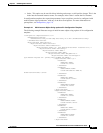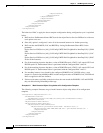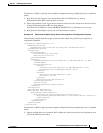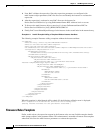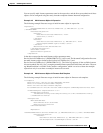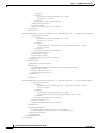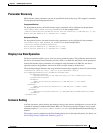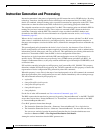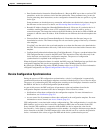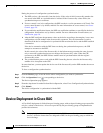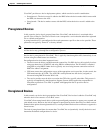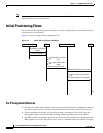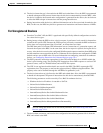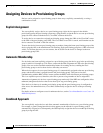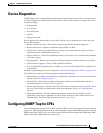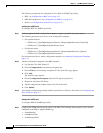
4-15
Cisco Broadband Access Center 3.8 Administrator Guide
OL-27172-01
Chapter 4 CPE Management Overview
Instruction Generation and Processing
• Data Synchronization Instruction (DataSyncRecord)—Keeps the RDU up-to-date on various CPE
parameters, such as the software version and the model name. These parameters may, in turn, be
used in generating other instructions, such as configuration instructions that are specific to a given
device type.
Some parameters are checked on every connection, while others are checked only when a change in
the firmware version occurs. For details, see Discovering Data from Devices, page 12-11.
• Routable IP Address Instruction (RoutableIPAddressRecord)—Discovers if a particular device is
reachable, enabling the DPE to create a TCP connection with a device in order to service a
connection request. The instruction retrieves the WAN IP address for the device, PPP or DHCP, and
compares it with the source IP address. If the IP addresses are different, the instruction updates the
RDU.
• Firmware Rules Instruction (FirmwareRulesRecord)—Determines the firmware image to be
downloaded to a device. The firmware image files are associated to groups of devices by a firmware
rules template.
Cisco BAC uses the rules in the associated template to evaluate the firmware to be downloaded to
the CPE. This instruction takes effect only if the device has been associated with a firmware rules
template.
• Configuration Synchronization Instruction (ConfigSyncRecord)—Triggers a synchronization of the
CPE configuration that is stored in the DPE cache. This instruction comes into effect only if the
device has been associated with a configuration template. The process of configuration
synchronization is explained in the subsequent section.
When the Signed Configuration feature is enabled, the RDU parses the ToBeSigned tag specified in the
configuration template and sets the corresponding value on the CWMP parameter object.
By default, the ToBeSigned flag on the CWMP parameter object is set to False. For more information
on Signed Configuration, see Signed Configuration for Devices, page 13-20.
Device Configuration Synchronization
During the process of CPE configuration synchronization, a device’s configuration is automatically
synchronized based on the configuration template associated with the device’s Class of Service object.
The process of synchronizing the CPE configuration according to the ConfigSync instruction stored in
the DPE for this device is called Configuration Synchronization.
As part of this process, the DPE configures all parameters values and attributes found in the
configuration template associated with a device through its Class of Service, so that:
• Notifications reflect those configured in the configuration template. For more information on
Notifications, see Notification, page 5-8.
• Access control for all parameters reflects that configured in the configuration template. For more
information on access control, see Access Control, page 5-9.
CPE configuration is associated with a unique configuration key. This configuration key is saved in the
DPE database, and is used as the ParameterKey parameter in RPCs that are forwarded to the CPE.
Every time the CPE establishes a connection with the DPE, the device reports the value for the
ParameterKey—in the form of a configuration revision number—by using the Inform message that the
device forwards to the DPE. The DPE compares this value with the one in its cache for the particular
device. A mismatch of the values, triggers the DPE and the device synchronization process.



